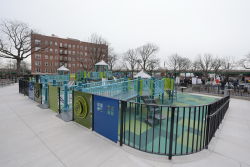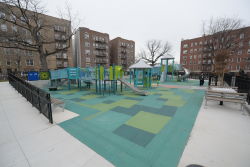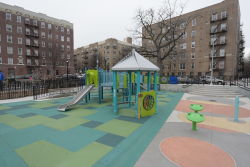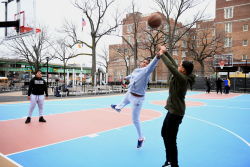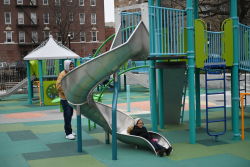Lyons Square Playground
Lyons Square Playground
What was here before?
Lyons Square Playground sits on the edge of the Hunts Point area of the Bronx, which was first populated by the Weckquaesgeek. Edward Jessup and John Richardson, European settlers who arrived in 1663, purchased the peninsula from the Weckquaesgeek. Upon Jessup’s death, the land passed to his widow’s son-in-law and area namesake Thomas Hunt Jr. Numerous wealthy families moved to the area through the early 1900s. The opening of the IRT Pelham line in 1920 drew both residents and industry to the area, becoming a thriving industrial zone that it remains today, known especially for the New York City Produce Market and Hunts Point Meat Market.
How did this site become a playground?
This site was acquired by condemnation on June 12, 1925, 35 years before the construction of the adjacent Bruckner Expressway. Shielded by a raised perimeter of trees from surrounding streets and the Bruckner Expressway, this playground provides a play space for residents and students of Public School 75 across Bryant Avenue.
In 2018, Lyons Square Playground was fully renovated as part of NYC Parks' Community Parks Initiative, a multi-faceted program to invest in under-resourced public parks and increase the accessibility and quality of parks throughout the five boroughs. It received a fully-reconstructed playground and multi-use area with ADA-accessible play equipment, a spray shower, basketball courts, a picnic area, ping pong tables, fitness equipment, and a new public restroom. The renovation also included new green infrastructure elements that capture stormwater. The park’s entrances and perimeters were improved as part of the Parks Without Borders Initiative, a design approach that makes parks more open and welcoming.
What is this playground named for?
Lyons Square Playground was named for landowner and Civil War veteran James L. Lyons by the Board of Aldermen on April 17, 1928. Lyons was a charter member of the Bronx Old Timers Association, founded in 1911 by the first Bronx Borough President, Louis Haffen, for people who had lived in the Bronx for fifty years or more.
James L. Lyons’ estate was nearby on Forest Avenue between Home Street and Boston Road. His estate previously belonged to Colonel Richard Hoe, for whom Hoe Avenue was named. Hoe achieved fame as the inventor of the rotary printing press, a steam-powered printer whose efficiency enabled publishers to expand the circulation of newspapers.
Check out your park's Vital Signs
Clean & Safe
Green & Resilient
Empowered & Engaged Users
Share your feedback or learn more about how this park is part of a
Vital Park System


